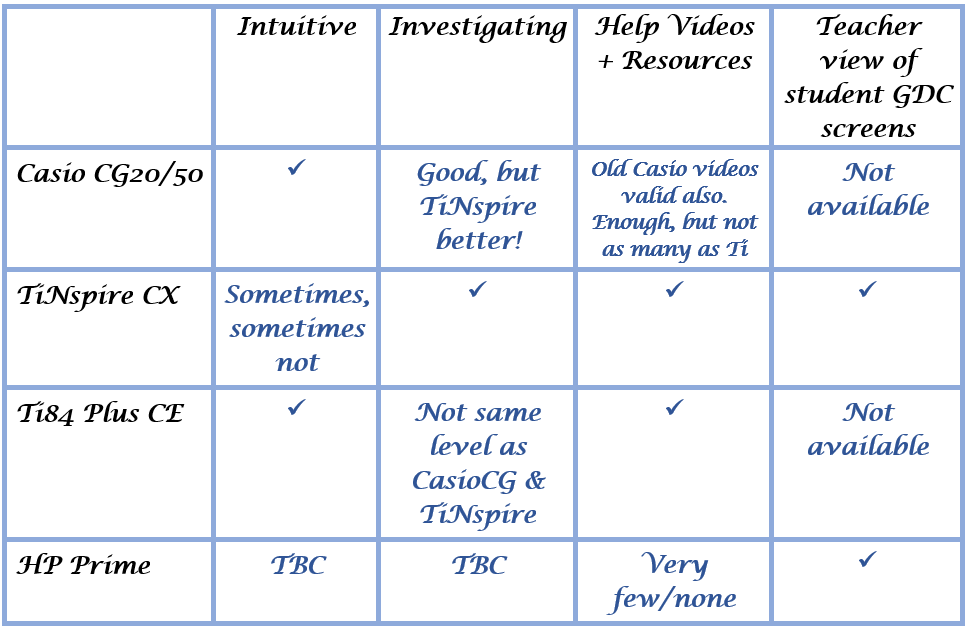Which Calculator (GDC) is best?
![]() The IB works hard, alongside the calculator manufacturers, to try and ensure that no calculator confers an advantage over another.
The IB works hard, alongside the calculator manufacturers, to try and ensure that no calculator confers an advantage over another.

If you're pushed for time, above is our summary for each of the three calculators against each of the four categories (TBC means 'To be confirmed' i.e. not sufficient time playing with the calculator to have come to a decision). A "tick" means that calculator is the winner for that given category. However, the "most ticks" won't necessarily mean, the best GDC for your classroom, budget and the weighted importance of each of the four categories, based on your students, will likely be different from class to class and school to school:
Which calculator is "best" often depends on which calculator the teacher has the most experience with. The more experience the teacher has with a particular model, the more fluidly they can help students and the more resources they are likely to have ready to help students get familiar with their calculator.
Budget - the price of each make and model can vary quite a lot from one country to the next. Availability of second hand calculators, if your school has always used a certain model, can also be a consideration. However, with second hand for sale websites e.g. ebay, I think which make and model you currently used, in terms of budget to students and parents, is less of an issue. Moreover, if you're ever going to change make and model at your school, the arrival of the new syllabus, and its emphasis on the calculator becoming more of an investigative tool (mathematic's toolkit, HL Paper 3, two calculator papers (new for 2012-19 SL&HL syllabi), is probably a good (easier to justify) time to do it.
I don't think there is a 'right' and 'wrong', 'definitive' answer here. It will depend on many things, including both the classes, and the teachers, familiarity and comfort with different makes and models and technology generally.
To help you decide what's best for your classes, I aim, below, to offer some concrete 'compare & contrast' examples of different techniques and investigation options, using each of the Casio, TiNspire and HP Prime.
These are divided into four main categories of consideration: intuition, online help, investigation capabilities, a GDC networked classroom.
1.How INTUITIVE is the user interface for a new user?
'Intuition' is defined here as: is the operation that a student may want to do visible within the same menu? Therefore, by simply ‘experimenting’ with the options offered, starting with the most likely (based on the titles of the options) and working their way down the list to least likely they should find the functionality they are looking for (and will have discovered numerous others they 'experimented' with before getting there - all of which are likely to help later!).
An interface can be thought of as less intuitive if the option a student is looking for is not visible within the current menu, obliging the student to think “where else might they be?”.
Of course, once a student has worked awhile with a make and model they will begin to understand the logic its designers used when selecting where to put what operations/functionality.
However, as IB teachers, it's important to be aware (I think) of the demands of the IB Diploma course, and that the time 'understanding the logic of a particular make and model' may require, could be too much - particularly for some SL students for who wouldn't have chosen mathematics at IB if it wasn't a 'compulsory' subject.
2.How easy is it to find ONLINE HELP when a student is 'stuck'/can't remember/work-out which button to press?
A quick "Youtube" search currently (summer 2019) sees Ti84 ahead (see video comparison below). The Casio CG20/50 function in a very similar way to simpler Casio fx-9750 models, so often either video is helpful. Certainly there are more TiNspire specific videos and very few CG20/50 specific videos. The HP Prime has very few video tutorials that turn up on Youtube searches. Please do email a video of any of your searches that provide evidence to the contrary (as this is an area that is likely to change over time).
Video Youtube search comparison in the hidden box below - click on the "eye" icon
3. Investigation capabilities of each calculators in-built software
. . . with the internal assessment: Exploration, HL Paper 3 and the additional hours offered in the "mathematical toolkit" - all of which help, and are designed to ensure an inquiry, concept focused classroom - the display and investigation functionality of each calculator is more important than ever.
4.Teacher software - view all students calculator screens direct from your desktop.
Personally, I think this is an absolute "must" for the applications and interpretation subject (budget permitting) given (a) calculator only exams, and (b) if teaching the HL course as well, with the required extended, problem-solving Paper 3. I'm not aware of a Casio equivalent (please email me a link if you know of a Casio equivalent and I'll modify this accordingly, with credits) to HP Prime's "Wireless kit" and TiNpsire's "Navigator". For me, this gives these two models the edge - Casio, if you're reading this, it would make a great addition to a good IB calculator.
